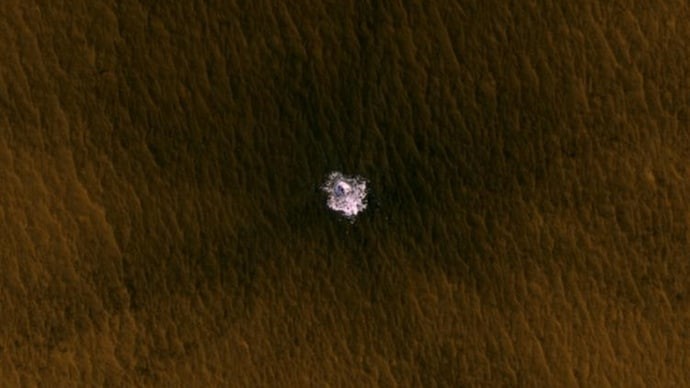Description

Disclaimer: Copyright infringement not intended.
Context
Nasa's Subsurface Water Ice Mapping (SWIM) project has released its fourth set of maps, providing the most detailed view of Mars' subsurface ice since the project's inception in 2017.
Details
Mars Ice Mapping with HiRISE
- Scientists use HiRISE (High-Resolution Imaging Science Experiment) to study fresh impact craters caused by meteoroids.
- HiRISE assists in the identification of subsurface ice on Mars, which may be excavated by impact events.
Subsurface Water Ice Mapping (SWIM) Project
- SWIM project, managed by Nasa's Jet Propulsion Laboratory, releases its fourth set of maps, providing detailed insights into Mars' subsurface ice.
- Maps help in identifying potential locations where Martian ice can be accessed from the surface, crucial for sustaining future astronaut missions.
- Ice serves as a vital resource for astronauts, offering drinking water and serving as a key ingredient for rocket fuel.
Collaboration and Mission Overview
- The project is a collaborative effort involving data from various missions, including Mars Reconnaissance Orbiter (MRO), 2001 Mars Odyssey, and Mars Global Surveyor.
- The latest map utilizes data from two higher-resolution cameras aboard MRO, offering a more detailed perspective of the ice's boundary line.
- Landing sites near the equator are prioritized due to the thicker atmosphere and relatively warmer temperatures, reducing energy requirements for maintaining suitable conditions for astronauts and equipment.

Importance of Impact Craters and Polygon Terrain
- Impact craters caused by meteoroids reveal locations where ground ice is unequivocally present.
- "Polygon terrain" indicates the presence of hidden ice beneath the surface, demonstrated by the seasonal expansion and contraction of subsurface ice.
Future Prospects: Mars Ice Mapper Mission
- SWIM project is expected to lay the foundation for a potential Mars Ice Mapper mission, equipped with specialized radar for comprehensive exploration of near-surface ice beyond current capabilities.
- Mars Ice Mapper mission aims to enhance our understanding of Martian ice distribution and composition, contributing to future scientific exploration and potential manned missions.
Introduction to Mars
- Fourth planet from the Sun, often referred to as the Red Planet.
- Considered a terrestrial planet with a thin atmosphere primarily composed of carbon dioxide.
Geology and Surface Features:
- Varied surface features, including impact craters, valleys, deserts, and polar ice caps.
- Prominent features such as Olympus Mons, the largest volcano in the solar system, and Valles Marineris, one of the largest canyons.
Atmosphere and Climate:
- Atmosphere primarily composed of carbon dioxide with traces of other gases.
- Extreme temperature variations, with temperatures ranging from as low as -195 degrees Fahrenheit (-125 degrees Celsius) to as high as 70 degrees Fahrenheit (20 degrees Celsius).
Exploration and Research:
- Numerous missions by various space agencies, including NASA and ESA, aimed at studying Mars' surface and atmosphere.
- Rovers like the Curiosity and Perseverance have provided valuable data about the planet's geology, climate, and potential habitability.
Potential for Life and Human Exploration:
- Presence of water ice and evidence of past liquid water suggest the potential for microbial life.
- Ongoing research and future missions aimed at assessing the planet's habitability for human colonization and exploration.

Conclusion
Mars serves as a crucial focus for understanding the conditions necessary for life beyond Earth. Exploration of Mars provides insights into the evolution of terrestrial planets and the potential for extraterrestrial life in our solar system.
|
PRACTICE QUESTION
Q. Which of the following statements about Mars is/are correct?
- Mars is the fourth planet from the Sun and is often referred to as the Red Planet.
- Olympus Mons, the largest volcano in the solar system, is located on Mars.
- The atmosphere of Mars primarily consists of oxygen, making it potentially habitable for humans.
a)Only 1 and 2
b)Only 1
c)Only 2
d)1 and 3
Answer: a)
|
















